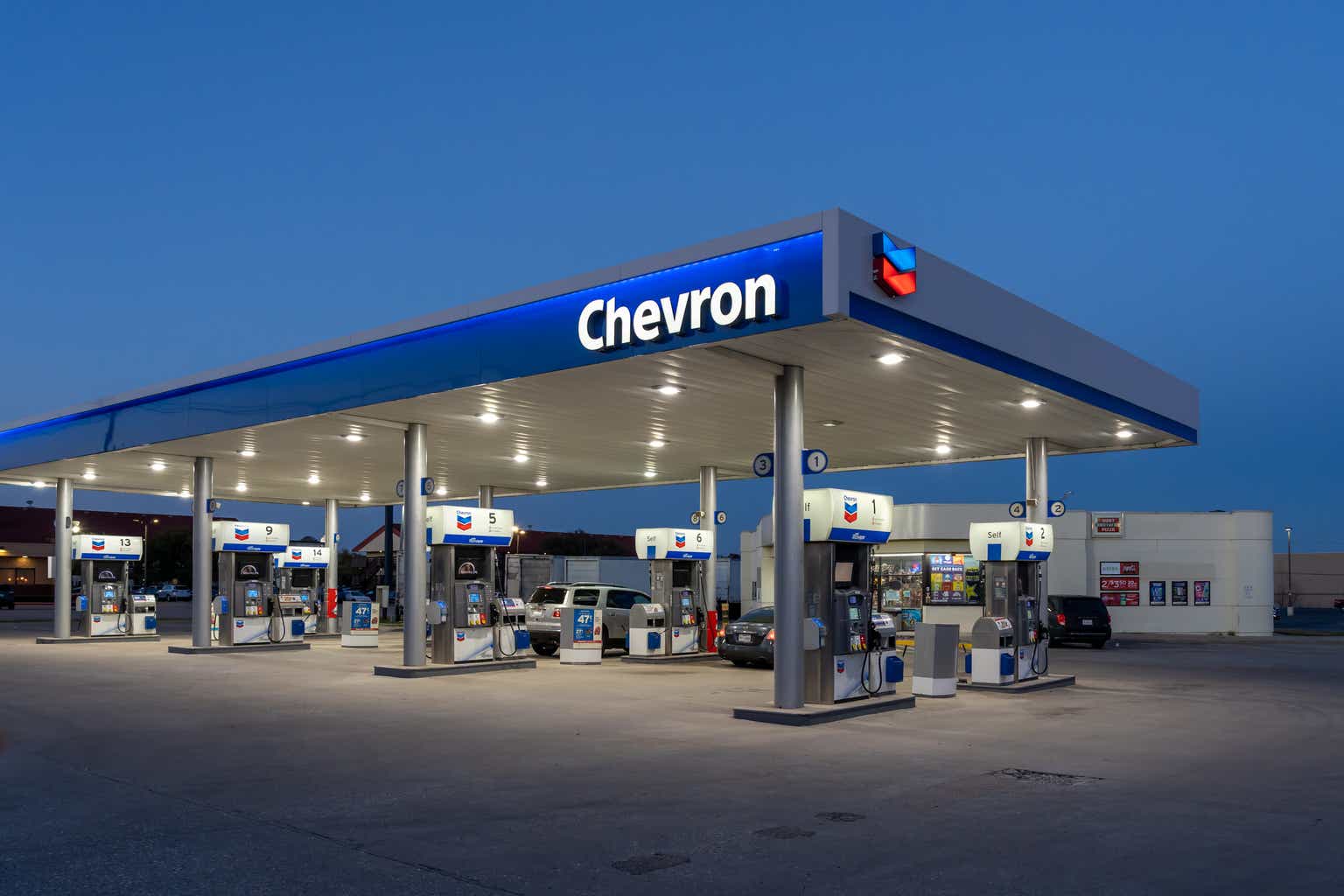A Chevron gas station at night is shown in Dallas, Texas, USA.
Lately it has become fashionable for writers to predict that WTI crude oil will go to $300 per barrel. Several commentators floated this price target in recent months, and countless news outlets repeated their claims. It all got started back in the oil bull market of 2022. That year, JPMorgan (JPM) put out a research note that said oil could go to $380 in a worst case scenario in the Russia/Ukraine war. The call got a lot of publicity, leading to a trend of writers forecasting oil will go to $300, in hopes of gaining attention. The $300 number was even seen in prestigious publications like Reuters, CNBC, and MarketWatch.
To lay my cards on the table, I don’t think that oil is going to $300 per barrel any time soon. Oil consumption has been rising lately, but the pace of increase over the last three years has only been about 2% per year. Supply has been going down, because the entire OPEC+ cartel is cutting output, but the supply side of the oil price equation could reverse in the future. It is heavily influenced by politics involving Saudi Arabia, other Gulf states, Iran and Russia. These nations’ leaders can be capricious in their decision making, but ultimately the long-run optimal oil price for them is mathematically discernible. They probably won’t base their oil output decisions on politics over long periods of time, at least not if they hope to maximize their wealth.
For this reason, we can expect the supply of oil to stay close to its historical range in the near term. The Saudis may cut or boost output briefly for political reasons, but their long run incentives argue for selling the profit-maximizing output.
It’s for this reason–among others–that I think Chevron (NYSE:CVX) stock is a good value today. We are likely not going to see oil prices reach a level where CVX will stage a monster rally, but prices should remain healthy enough for the company to pay its dividend, and maybe even deliver modest capital gains. This is significant because the stock’s current dividend yield–3.66%–is far above average. If investors just realize a modest 10% capital gain on their CVX shares over the next five years, then their total returns will be substantial. In this article I make the case that CVX stock is a decent buy today–not because oil will go to $300 or any other ultra-high target, but because it can make very good money at the oil prices we’re seeing now.
Chevron: an Overview
Chevron is an energy company involved in the oil industry in a number of different ways. It sells oil, natural gas, diesel and jet fuel. It operates a natural gas business, which includes LNG transportation services. It’s one of the largest leaseholders in the Permian Basin, which Warren Buffett and Charlie Munger consider one of the best oil fields in the world. It has 1 million barrels per day of refining capacity. Finally, it has a chemicals business, which transforms crude oil into chemicals needed for heavy industry.
Chevron is a pretty diversified, full-service oil and gas business. That’s a good thing, because it allows the company to make money in different market conditions. Pure play E&P companies tend to make the most money in oil bull markets, because they sell oil and gas on the open market. Refiners on the other hand can make good money even when the price of oil is fairly low, because their business involves purchasing oil in order to refine it into gasoline, diesel or some other usable fuel. Compared to a pure play E&P like Occidental Petroleum (OXY), CVX won’t gain as much from rising oil prices, but it won’t suffer as much when oil prices go down either.
This diversified business model is a major competitive advantage for Chevron.
Being involved in exploration, production, refining and sales, the company can capture profit at many different points along the oil & gas supply chain. Whereas a pure play E&P can only make money selling crude oil, Chevron can extract, refine and sell (in the form of gasoline), the same barrel of crude. This ultimately enables Chevron to earn higher margins than many of its competitors.
Chevron: Recent Results
In order to gauge how well Chevron will do in its upcoming third quarter release, we need to look at previous earnings releases from periods when oil was at about the level it’s at now. According to Oil Price, WTI Crude was hovering around $90 in the fourth quarter of 2022, much like it is today. So, Q4 of 2022 could be a good indicator as to how 2023’s third quarter will turn out.
In the fourth quarter of 2022, Chevron earned:
-
$54.5 billion in revenue, up 19% year-over-year.
-
$6.3 billion in GAAP earnings, up 25% year-over-year.
-
$7.9 billion in adjusted earnings.
-
$3.33 in diluted EPS, up 27%.
Pretty decent results. The second quarter of 2023 on the other hand was not as good. Its results included:
-
$48.4 billion in revenue, down 51%.
-
$6 billion in GAAP earnings, down 48%.
-
$5.8 billion in adjusted earnings, down 50%.
-
$3.20 in diluted EPS, down 46%.
As we can see, Chevron’s results for the most recent quarter were worse than those seen two quarters prior. However, the price of oil today is closer to that seen in the fourth quarter of 2022 than in the second quarter of 2023. So, there is a decent probability that the company’s upcoming earnings will look more like the Q4 2022 release than the Q2 2023 release. If that’s the case, then CVX will beat on revenue, as analysts are only expecting $49 billion in sales
Valuation
Having looked at Chevron’s recent earnings, we can now turn to its valuation. At today’s prices, CVX stock trades at:
-
10 times adjusted earnings.
-
10.5 times GAAP earnings.
-
1.46 times sales.
-
7.5 times operating cash flow.
-
11.46 times free cash flow.
Speaking of free cash flow:
Chevron does pretty well in terms of discounted cash flows. If you take the $14.5 in TTM free cash flow per share, and discount it at the current treasury yield (4.5%), assuming no growth, you get a $322 fair value estimate. If you incorporate a risk premium of 6%, you get a $138 fair value estimate. The average of these is $230, which implies 38% upside to Friday’s closing price.
Risks and Challenges
As we’ve seen, Chevron stock certainly does not need $300 oil, or anything close to it, in order to have upside at today’s prices. To my mind, that makes it a buy. However, there are many risks and challenges facing chevron stock today, including the following:
-
Oil prices going lower. Any number of factors could cause oil prices to decline. OPEC+ could reverse course. A pandemic could necessitate lockdowns that kill demand. Countries could ramp up their investments in nuclear power. None of these things appears likely to happen soon, but over a 5-10 year timeframe, they could take place. The higher oil prices go, the louder the calls to embrace nuclear will become. If oil prices reach anything like $300, the investments in nuclear power will probably start ramping up pretty quickly.
-
Rising interest rates. Chevron is a pretty capital intensive company, like most oil companies are. It currently has $21.5 billion in debt. That debt carries about $500 million in annual interest expense. Should the Fed resume rate hikes at its next meeting, Chevron’s interest expenses will rise. That could take a bite out of the company’s earnings power.
-
Regulatory risk. Chevron, as a company that sells fossil fuels, is vulnerable to climate change regulations. If the U.S. government implements a carbon tax or bans gas powered cars, CVX’s sales will likely suffer. Currently, the U.S. has no plans to do that, but some foreign countries like Norway are phasing out gas-powered cars. Under Norway’s plan, none of the country’s citizens will drive cars powered by combustion engines by 2025. We can’t fully rule out policies like Norway’s coming to Chevron’s major markets. So, environmental regulations are a risk for CVX shareholders to watch out for.
The Bottom Line
The bottom line on Chevron is this: it’s cheap, it’s profitable, and it’s likely to post renewed growth in its third quarter earnings release. We’re probably not going to see $300 oil anytime soon, but it doesn’t matter. CVX stock is a buy anyway.
Read the full article here









Leave a Reply